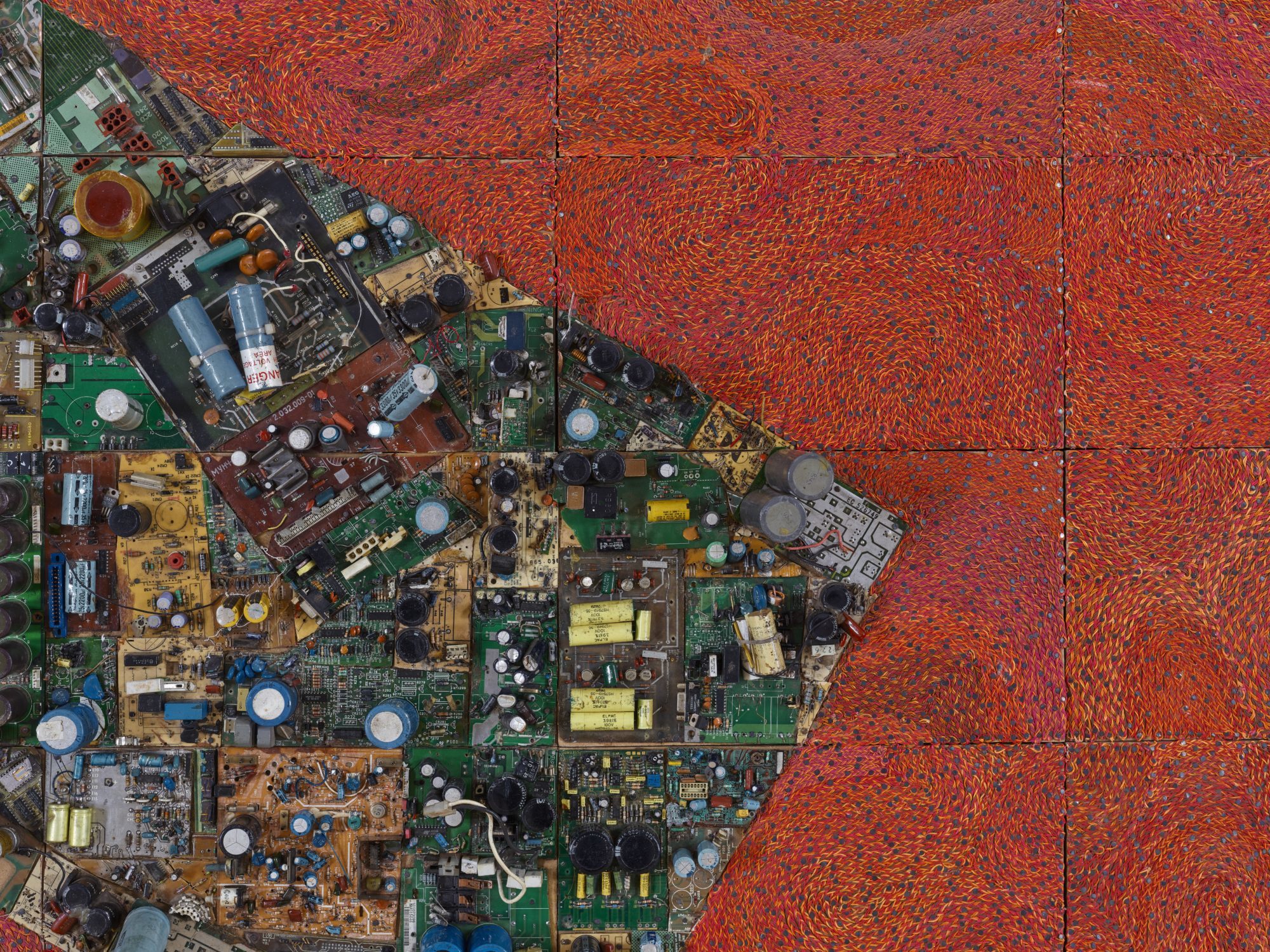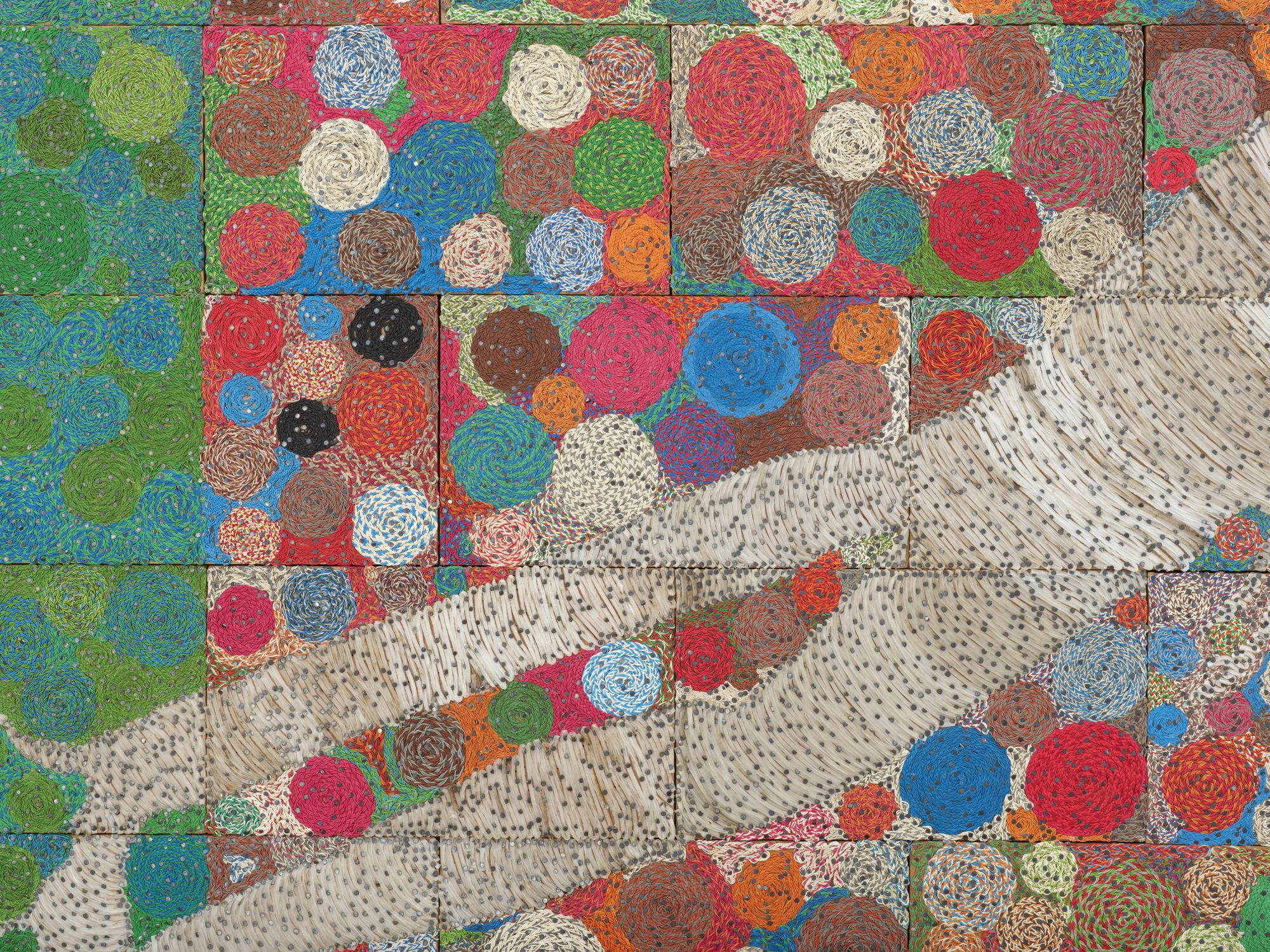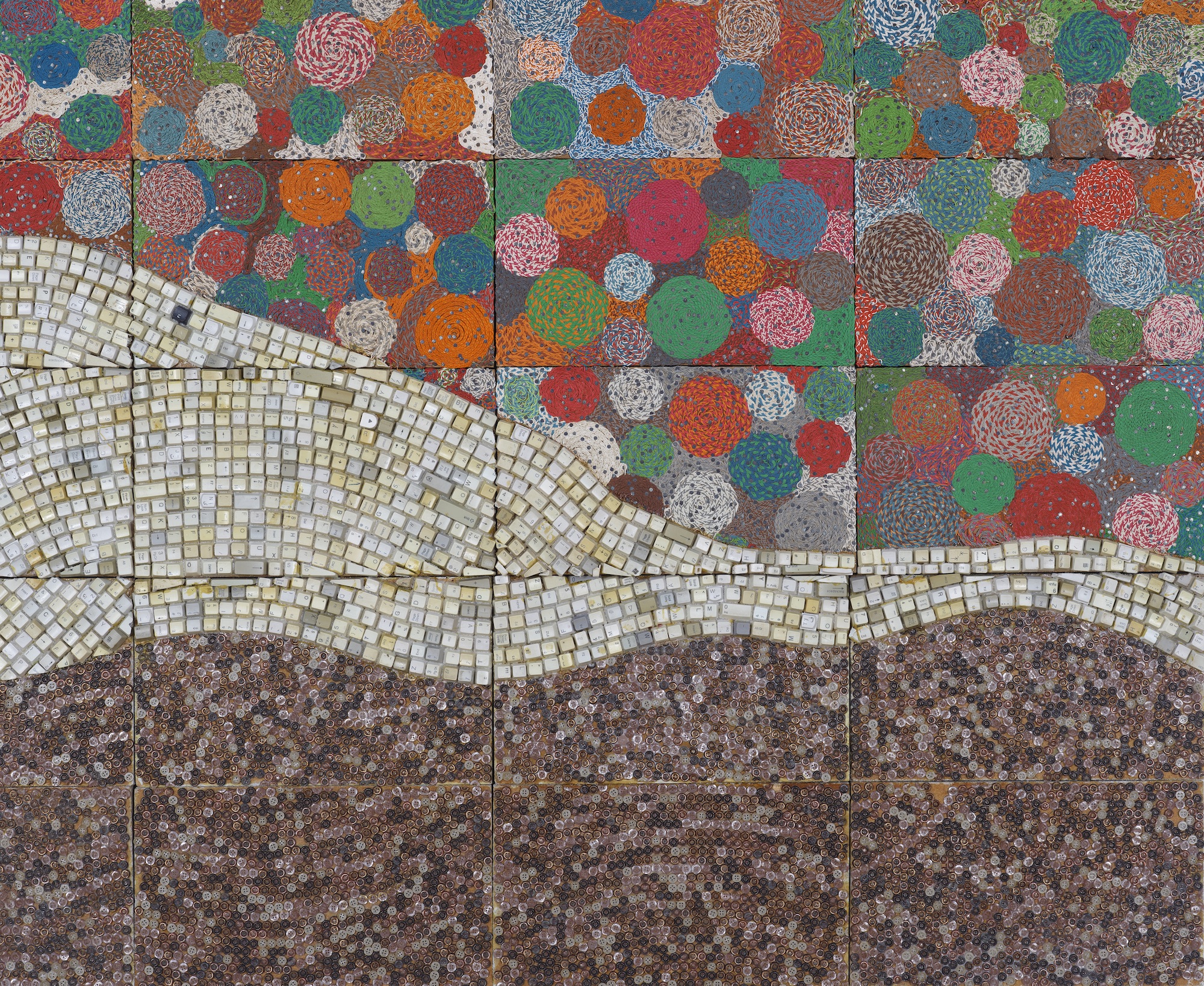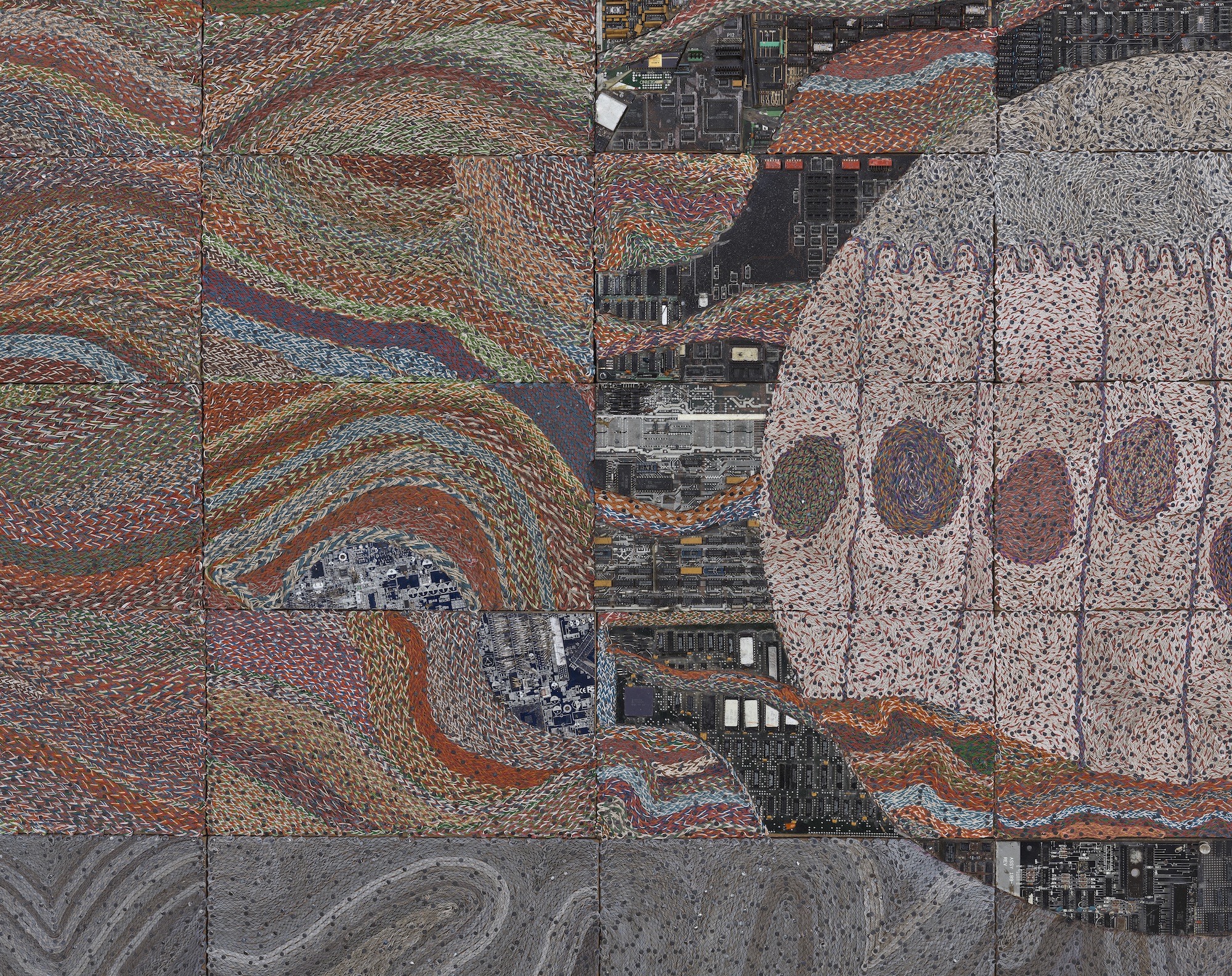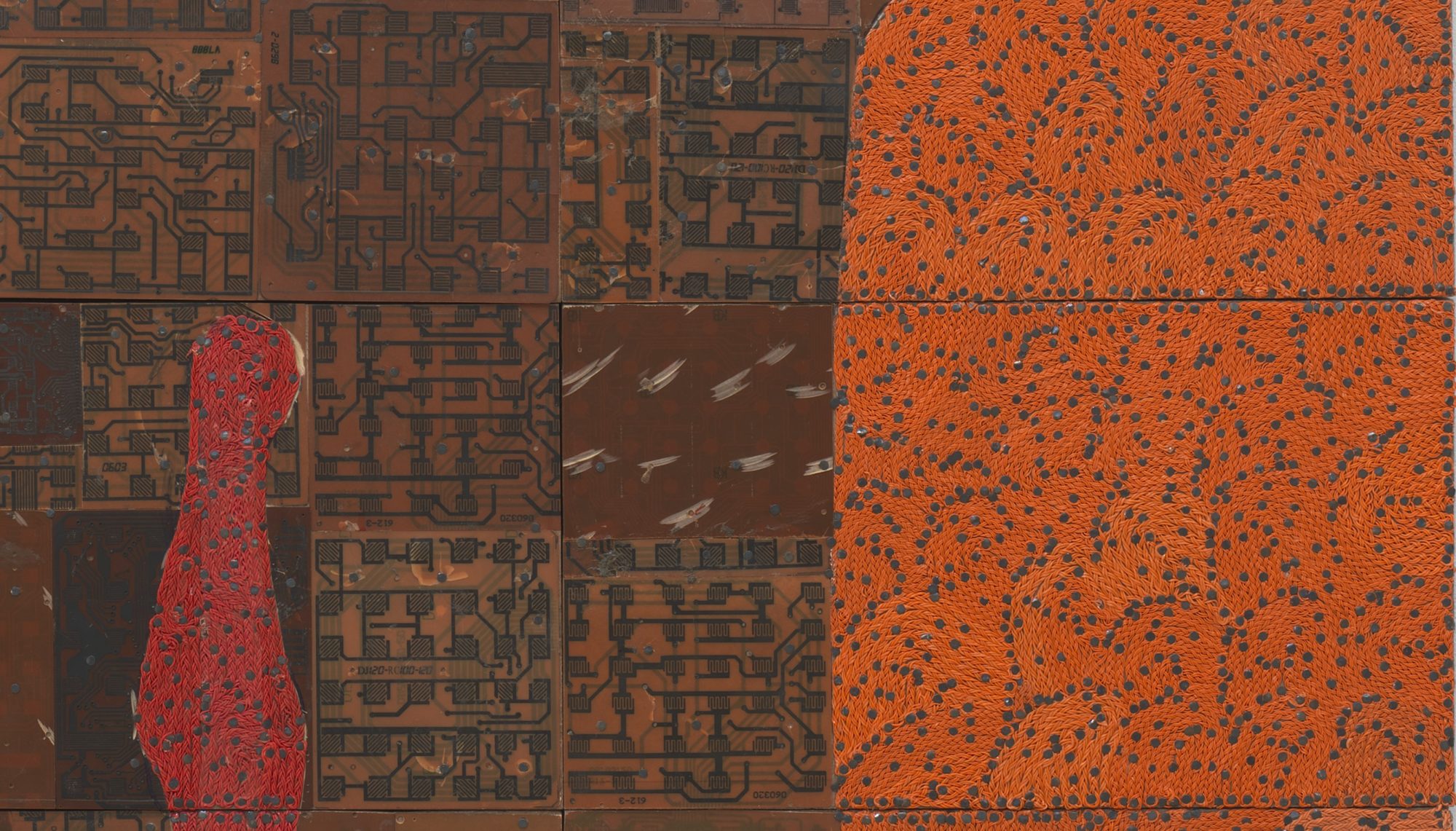We Were Creative Before We Were Human
Elias Sime, Tightrope: Evolution (1) (detail), 2017 [courtesy of the artist]
Share:
Freshly back from excavating in the Afar desert of northeast Ethiopia, Yonas Beyene PhD sat down in his Addis Ababa office to discuss the origins of human creativity. Amid the dusty hardbound periodicals and plaster casts of numerous ancestors’ skulls, Beyene waxed poetic about the aesthetic capabilities of hominids. Corwin and Beyene discussed the dicey question of why many humanoid bones show signs of careful defleshing—funerary rites or cannibalism? Beyene links the earliest clear signs of creativity—the fabrication of stunning hand axes three-quarters of a million years ago—with more “contemporary” traditions of cave painting, and modern humans.
Will Corwin: When I first called you, you were driving back from the Afar region, and you didn’t even know what day it was! Can you tell me a bit about that excavation in Afar?
Yonas Beyene: When you called me, I was concluding an excavation in Afar. This year we were working on a Middle Stone Age site in an area that we call Halibee. That site is very rich, and we stayed there for 37 days, excavating at 4 locations.
WC: Can you talk a bit more about what you found? You said bones and stone tools. I think most people know Afar as the place Lucy was found, at Hadar, but it is probably the source solely responsible for the remains of most of our human ancestors. Were you looking for something specific? What was the nature of the site at which you were digging?
YB: The Afar is a big place. We’ve been working there for the past 37 years, in different time horizons, trying to open up windows in these horizons. Some of these time horizons have cultural materials, meaning archeological sites. Others are purely paleontological. But both the paleontological and the archeological sites all give you environmental information, which is key to understanding human evolution. There are some very old findings, such as the Ardipithecus kadabba, from 5.8 million years ago, all the way to anatomically modern humans, which are dated to 80,000 years in the sites where we are working, in the Middle Awash [research area]. We have been excavating in archeological sites dated to 2.5 million years ago, where about 20 years ago, the site where Australopithecus garhi was discovered, and we discovered cut-marked bones—bones which were cracked open for their marrow [through the use of] stone tools. We were also retrieving stone tools from that period. From that time all the way to 80,000 years ago, and even up to the Neolithic period, to the time just before agriculture, we keep on finding cultural materials—cultural materials left by early humans. This year’s focus was to work in sediments which are dated to be broadly between 55,000 and 100,000 years ago, and we were also looking at sediments which were dated a little bit earlier. This … period covers what we call the Middle Stone Age.
Elias Sime, Tightrope: Narcissism (detail), 2017 [courtesy of the artist]
WC: Two questions, to clarify. The Oldowan1 stones: how can you tell these are tools?
YB: First there is contextual information. When you find these tools, they are in a geological context. Then there are signatures: when you hit a stone with a stone hammer, you apply force—that force leaves a signature on the core from which the flake is detached, and on the flake itself. On the flake you find a platform where the stone hammer hits the mother core. You find also a bulb, and striations, for the experienced eye, which you can read. In addition you have the contextual information, and that information can tell you how one stone flake and core are related to each other. It’s not only that. In the contextual information you may also have bones—people did not crack stones just for the enjoyment of cracking stones. They cracked stones, they flaked sharp tools in order to cut certain things. Among those things that they cut were animal flesh. Animal flesh does not preserve in the fossil record, but you find associated bones—sometimes cracked open, just as in Bouri, with Australopithecus garhi. [Archaeologists working at other sites] have been able to bring back the flakes and [reconstruct] the original core: these were artifacts, the hallmark of the beginning of human technology. They were just at the dawn of their humanness, which appeared [more than] two million years ago.
WC: My second question about the Oldowan technology is that these aren’t human, Homo sapiens, that are making these tools, these are a different species of hominid.2 Do you have any sense of the level of complication of these tools being made? Did this take problem solving?
YB: Stone tool use does also exist among apes, primates. They use them, and they sometimes [crack open rocks], but not in a coordinated form—not culturally, not repeatedly. In [hominid] times we have stone tools in the thousands—[for example,] from Gona, again in the Afar—dated to 2.6 million years ago. If you make stone tools at this time and at this quantity, that means there was a culture: people were doing it repeatedly, and that means there was a pattern. Of course, these were not us, not Homo sapiens. We don’t know who made those stone tools 2.6 million years ago, but we have candidates. One [possible] candidate is Australopithecus garhi. We discovered cut-marked bones, showing that the person who lived at that time, that hominid,3 was cracking open long bones for their marrow. Australopithecus garhi is not even genus Homo, [as A. garhi had] a brain capacity less than Homo, which is 450 cubic centimeters. The brain capacity was small—just like chimpanzees—but those guys [might have been] already making stone tools. These were not us: the earliest Homo that we have appeared around 2.8 million years ago, based on recent findings in the Afar. [We] find several sites of Oldowan stone tools, and we have Homo habilis with a brain capacity a little bit larger than 600cc. We’ve found more sites in Ethiopia, in Tanzania, and in Kenya.
Elias Sime, Tightrope: Evolution (1) (detail), 2017 [courtesy of the artist]
WC: To go back to the tools that you’ve discovered, which are solid, factual pieces of evidence: when you examine an Acheulian4 tool, which is symmetrical, pear-shaped, and has been worked, in your opinion, do you find them beautiful, do you like looking at them?
YB: Yeah. Acheulian has different stages—that is what our recent work at Konso-Gardula demonstrated. In Konso we have Acheulian tools in their earliest form, from 1.75 million all the way to 850,000 years ago, which covers a period of [about] one million years. During these one million years, we see stages of evolution of that Acheulian technology. You can [imagine the person through the shape of the tool], as he was composing something intricate. From 850,000 years ago, you have a very beautifully made and … soft-hammer-prepared tool. Looking at those things you can see that the person who made it knew about it from the very beginning—he had it in his brain: it was preconceived. He was following it throughout the whole process, and at the end he produced something beautiful—it’s more than a tool. You don’t need such perfection if the end use is just to cut up animal carcasses. You can see some notion of beauty and aesthetic coming out of those stone tools, and this aesthetic is very old. In the earlier period, when the Acheulian was full-fledged at 1.4 million [years ago], you find hand axes mostly for practical use. The later hand axes … they were [also] for use—hand axes are very practical for cutting, chopping, fast processing of carcasses; chopping wood. There are different forms—[types] that fall into different categories. But the most beautifully made hand axes—just like the ones at 850,000 [years ago], and like the ones which were discovered in Atapuerca, Spain, near the city of Burgos, at 400,000 years ago—were never used but were discovered in a pit with about 30 [sets of] human remains. A hand ax was discovered in England with a shell [naturally embedded in the rock, which was left there intentionally]. It was knapped all around a [fossil] shell—a bivalve was left intact there—it’s in the formation of the rock itself. There is a sense of beauty, a sense of harmony. Those people were looking—not only making beauty—but also [perhaps] admiring it in nature, and they were making it so that they can have it.
WC: Back to the Oldowan: do you see this motivation there?
YB: No, we don’t see that. It’s just use. Even during the early days of the Acheulian, what you have is hand axes that are very practical tools for chopping, [digging,] and cutting. In the later time, since 850,000 years ago, people started to make [additional] sense out of what they’re making, and some prehistorians think the man was looking at himself through the objects he was making. That’s more debatable, and you can’t prove it, but it’s a point to [consider]; it’s an argument to address and to discuss. Sometimes other forms of intelligence cannot be preserved, and we cannot find it in the sediments. What we find are only the bones and the stones, the only things which are preserved.
Elias Sime, Tightrope: Evolution 2 (detail), 2017 [courtesy of the artist]
WC: Now, I think it goes without saying that the sites of the individuals that you recently excavated—55,000 years ago to 100,000 years old—belonged to anatomically modern humans who probably had language and could communicate as we do … maybe?
YB: Those [hominids] surely communicated with each other. Even before that, when you go to the Acheulian, by 800,000 to one million years ago, there was a form of communication, and even before that. But how deeply were they communicating? Were they conveying their messages to each other? [As] you know, language goes [and develops] with technology, language is how you perceive your surroundings. The more knowledge of your surroundings you have, your language about your [surroundings] grows much larger.
WC: So, you don’t think it’s involved with emotion?
YB: The emotional communication is always there, but language with the sense of grammar, with the ways of words—the insinuations—language is deeper than just communication. As for communicating: they are communicating. [As experts in the area note, even] Homo erectus had the bone structure of the mouth [that] is not very different from ours. That also plays a role in formulation. The bones and the structure of the neck and the vocal area [are] more or less developed. The faculty was there. They were able [to speak] biologically. But [I think that the power of] languages, even today, in cultures that do not have much technology, is limited because there is no need to express those things. Language goes with your [environment], with your philosophy, the way you view the world, and it’s not only how you view the world. You have to express how you view it based on your understanding of the environment and the culture of communication as well.
Those people were communicating. They had the capacity for language, but to what depths they were using that faculty doesn’t fossilize or preserve, so we cannot say. But for sure, a person with the capacity of making those beautiful hand axes—a person who foresaw the final product of the [artifact] within the core, had states of thinking. The hand ax—the artifact he composed in his brain—was made reality. I think that guy had the capacity for complex thinking, and if he had the capacity for complex thinking, he had the capacity for language.
Elias Sime, Tightrope: Internalized (detail), 2017 [courtesy of the artist]
WC: Because that individual was also training others to make these hand axes ….
YB: [For sure] there were interactions, and education was the basis for their survival. The master knapper had to educate the younger generations, not only in stone tools but in the hunting techniques. Even animals teach their offspring[—the animal way], whereas humans are more sophisticated, with more brain and a well-established culture, so education was always there. Education in its old form, for survival, was always transmitted from generation to generation, and from group to group.
WC: When I was in the museum here in Addis, there was a small placard talking about indications of cutting on the human bones. Now, I’ve seen this read in different ways: when I was in the Dordogne, in France, they said that this was probably some kind of cannibalism. In the Ethiopian museum they said it was burial rituals. What do you make of these indications? We have an example right there on your shelf—the Bodo man has little slices in his skull. What do you think they are?
YB: I think rituals can be inferred from marks on the bones. And bones indicating those marks are present—they are clearly there. Bodo man shows some cut marks, on the brow ridge and on the cheeks. So, those cut-marks were deliberately made using stone tools, stone flakes …. There is not much meat on the face and the skull, but somebody was processing that skull 600,000 years ago. And adoration of the dead and consciousness of death [must have] existed at that time, demonstrated in different sites. The Atapuerca site is indicative of that. The hand ax that was found in the middle of about 30 individuals’ skeletons is [suggestive] of a votive present for the dead. By 165,000 years ago at Herto, there is Herto man, who is a Homo sapien idaltu. We have three skulls [from that site], and … these show processing of the skull. And especially one: there is a child’s skull which shows handling—it had been handled for a long time.
Elias Sime, Tightrope (detail), 2017 [courtesy of the artist]
WC: How do you see handling in a 165,000-year-old skull?
YB: Smoothness. The smoothness on the skull, which you don’t find on the other skulls. It’s not geological, it’s not taphonomical, but it was pre-burial [pre-fossilization]. We interpret that it could be associated with some kind of ritual. [It may be that] those guys had some connection with that child. It was not buried right away—if there was any burial. It was handled, it was [kept] around—so it is possible that there were rituals … going on, at least from that time. If not earlier.
WC: And you think the burial might have been the reason … you were able to find it? Do you think it was buried?
YB: There is no way to tell. It is the taphonomy5 that helps you interpret [the depositional history of] the bones you find. If you find a skeleton in more or less intact form, you [may be] tempted to think it was left intentionally, and/or no [carnivore has found] it in [the] wild landscape. Or perhaps fast deposition of sediments which buried that [individual] or that animal fast—which is [also] a possibility. So, you leave all possibilities open. [To be sure about burial sites you will] need burial marks. But you find art from earlier times, as early as the appearance of anatomically modern humans, and the beginning of modern behavior. Art was always there. [It might even have its inception] during the [late] Acheulian period, with those beautiful hand axes. It was there, it was just not expressed the way we see it today. It found its apex much later: 30,000 years ago you have Grotte Chauvet, and Lascaux and Niaux [elsewhere] in Europe. They are great works of humanity, and they show that humans were not just dummies before they started agriculture. They were doing things, and they knew anatomy. I think humans were always artists.
The artworks featured in this article are by Elias Sime, an Ethiopian artist who has spent his career crossing disciplines and finding new ways to connect objects and ideas. Recognized for his collage and sculptural works, Sime’s materials include animal skins and horns, plastics, threads and buttons, and mud and straw are often used as adhesives. Sime’s multiplicity is equally apparent in his knack for fusion between the figurative and the abstract, which artfully engages in and sparks robust cross-cultural dialogue. Beginning this September, Elias Sime: Tightrope will be on display at the Ruth and Elmer Wellin Museum of Art at Hamilton College in New York.
References
| ↑1 | Oldowan: earliest epoch of hominid stone tool making, between 2.6 and 1.7 million years ago, named after the Olduvai Gorge in Tanzania. |
|---|---|
| ↑2 | Hominid: members of the genus Homo, which excludes all other primate species. |
| ↑3 | Hominid: the family Hominidae, which includes the genus Homo and members of the primate order known as the great apes. |
| ↑4 | Acheulian: a category of tool named after one of the early sites of their discovery, St. Acheul in France; this word names the second epoch of hominid stone tool making, dating between 1.7 million and 280,000 years ago (which varies, depending upon the sites). |
| ↑5 | Taphonomy: the study of the processes (such as burial, decay, and preservation) that affect animal and plant remains as they become fossilized. |
